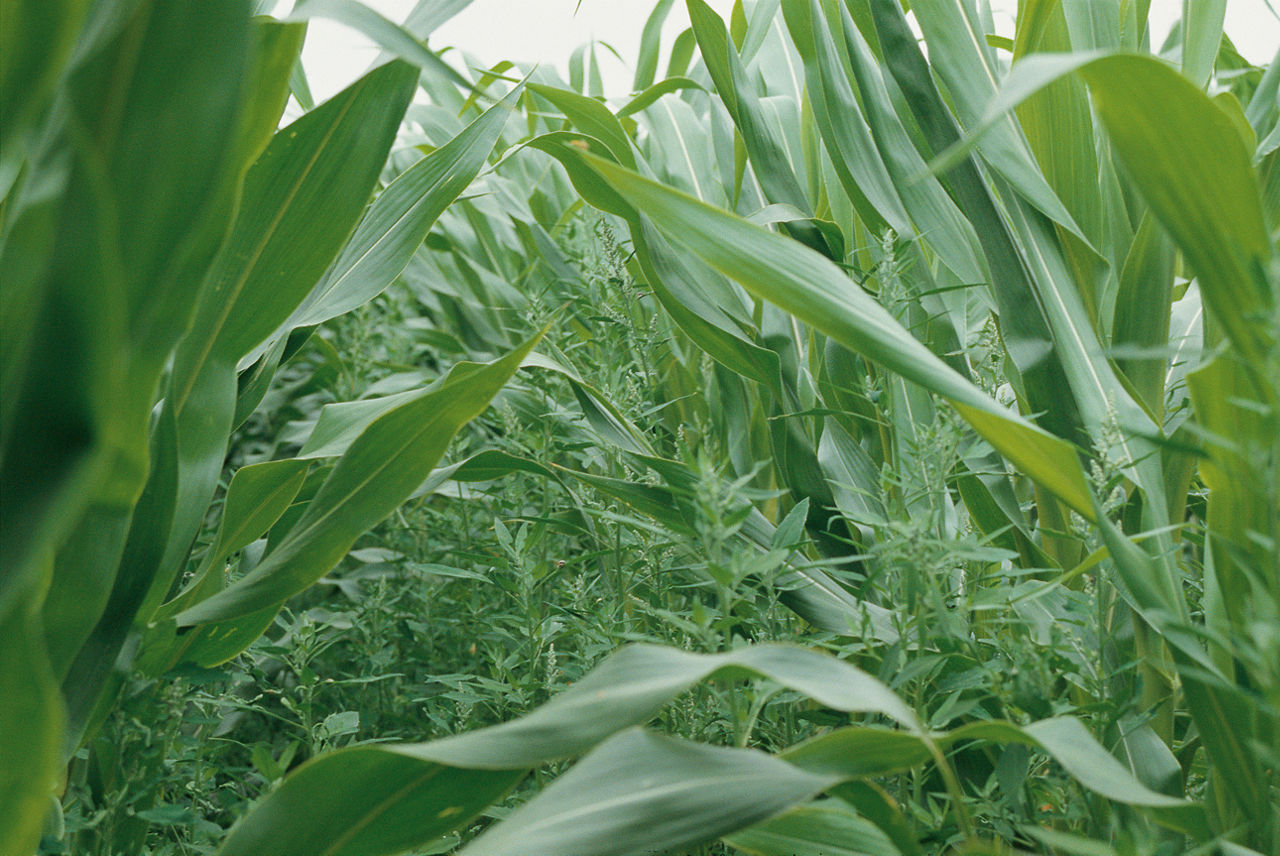Weed infestation impact on nutrient availability in corn
April 15, 2024
- Weeds have a major impact on crop yield potential by competing for limited resources such as sunlight, water, and nutrients.
- In addition to reducing yield potential, weeds can impact crop production by interfering with harvest efficiency, contributing to the weed seed bank, potentially be alternate hosts for pests, and detract from field appearance (Figure 1).
- The likelihood of potential yield loss is greater when weeds compete with corn plants during early growth. The extent of yield loss is dependent on weed density, time of weed emergence in respect to crop growth stage, and the weed species present.
- Understanding interactions among corn, applied nitrogen (N), and weeds is important in developing management strategies. The amount of N uptake by corn is dependent upon many factors such as weed species, weed density, and the rate and formulation of applied N fertilizer.

Relationship Between Fertilization and Weeds
Numerous studies have investigated how changing nutrient availability via fertilization can influence the competitive relationship between weeds and a crop. Fertilizer use can influence weed emergence, persistence, dormancy, dynamics, growth, and weed dispersion attributes. The rate, timing, type, and method of fertilizer application can impact biological trends of weeds.1 In some situations, fertilization favors crop growth over weed growth and reduces the potential for yield loss and in other situations, weed growth exceeds crop growth.
A University of Wisconsin study suggested that the utilization of N by weeds reduces N availability to corn plants; therefore, higher N rates are required to optimize yield potential. Although the N used by the weeds was eventually mineralized after being controlled with a glyphosate application, it was not available quick enough to satisfy the immediate needs of the corn crop.2 Additionally, a study conducted in eastern Nebraska also found the effects of N fertilization on early-season crop growth provided a competitive advantage for corn relative to weeds.3
Critical Period of Weed Control
The critical period of weed control (CPWC) is when weeds emerge with the crop. The critical period is the length of time following corn planting that weeds can grow with the crop before yield potential is impacted.4,5 This is basically how long you can wait before controlling the weeds without compromising corn yield potential. The critical period is influenced by the weeds present and their density, emergence timing and duration of emergence, environmental conditions, and cultural practices. Since the critical period can vary widely depending on the conditions, there are no simple guidelines to accurately predict for all situations. Research at the University of Nebraska has documented that each crop species has a CPWC during which weeds must be controlled to maintain maximum yield potential.6 The length of the critical period is influenced by cropping practices, including the N level in corn.7
Early-season weed competition causing corn yield loss can begin soon after planting. Testing conducted in glyphosate-tolerant corn over two years across multiple sites and states suggested that the optimum timing for initial glyphosate application to avoid yield loss was when weeds were less than 4 inches (10 cm) tall, no more than 23 days after planting, and before the V4 stage of corn growth.8 Remember these are only guidelines, and it is important to understand that timely early-season weed control is critical to protect corn yield potential.
Management
Control of weeds with tillage prior to planting is another method to reduce weed density. Annual weed control can be greatly enhanced if primary tillage is used in combination with delayed planting, which allows the annual species to germinate prior to the tillage operation.9 However, if tillage is delayed to the point where weeds become larger, the effectiveness of tillage as a control tactic can be reduced. Weeds that are not killed by tillage can be more difficult to control with herbicides later in the season.9
Control of existing vegetation with a burndown herbicide application before or at the time of planting is one option in a no-till system. If burndown applications are made in combination with residual (pre-emergence) herbicides, they reduce competition from existing vegetation long enough for corn to get established and to allow for rainfall activation of the residual herbicides. If residual herbicides are not used, burndown treatments provide a window for total post emergence weed control programs to be applied.
Sources
1Bajwa, A.A., Ehsanullah, Anjum, S.A., Nafees, W., Tanveer, M., and Saeed, H.S. 2014. Impact of fertilizer use on weed management in conservation agriculture- A review. Pakistan Journal of Agricultural Research 27(1):69-74.
2Hartzler, B. Managing weeds to protect crop yields. Integrated Crop Management. Iowa State University Extension and Outreach. https://crops.extension.iastate.edu/encyclopedia/managing-weeds-protect-crop-yields
3Knezevic, S. 2007. Timing weed control in corn to get the most effect. CROPWATCH. University of Nebraska-Lincoln. https://cropwatch.unl.edu/timing-weed-control-corn-get-most-effect
4Gower, S.A., Loux, M.M., Cardina, J., et al. 2003. Effect of postemergence glyphosate application timing on weed control and grain yield in glyphosate-resistant corn: results of a 2-yr multistate study. Weed Technology 17:821-828.
5Knight, A.M., Everman, W.J., Jordon, D.L., Heiniger, R.W., Smyth, T.J. 2017. Interactions of nitrogen source and rate and weed removal timing relative to nitrogen content in corn and weeds and corn grain yield. International Scholarly Research Notices. Hindawi. https://www.hindawi.com/journals/isrn/2017/8961367/
6Gantoli, G., Ayala, V.R., and Gerhards, R. 2013. Determination of critical period for weed control in corn. Weed Technology 27:63-71. Cambridge University Press.
7Hartzler, B. Impact of early-season weed competition on corn nitrogen needs. Integrated Crop Management. Iowa State University Extension and Outreach. https://crops.extension.iastate.edu/encyclopedia/impact-early-season-weed-competition-corn-nitrogen-needs
8Cahoon, C., Curran, W. and Sandy, D. 2019. Pre-plant mechanical weed control (Chapter 13). Post-plant mechanical weed control (Chapter 14). A Practical Guide for Integrated Weed Management in Mid-Atlantic Grain Crops. pp. 96 -127. Universities of Penn State, Rutgers, Delaware, Virginia Tech, West Virginia, and the United States Department of Agriculture-Beltsville. https://growiwm.org/wp-content/uploads/2020/12/IWMguide.pdf?x63934
9Weed control in zone/no-tillage corn. Field Crops. College of Agriculture and Life Sciences. Cornell University. https://cals.cornell.edu/field-crops/corn/weed-control-corn/weed-control-zoneno-tillage-corn
Web sources verified 3/22/24. 1213_103099